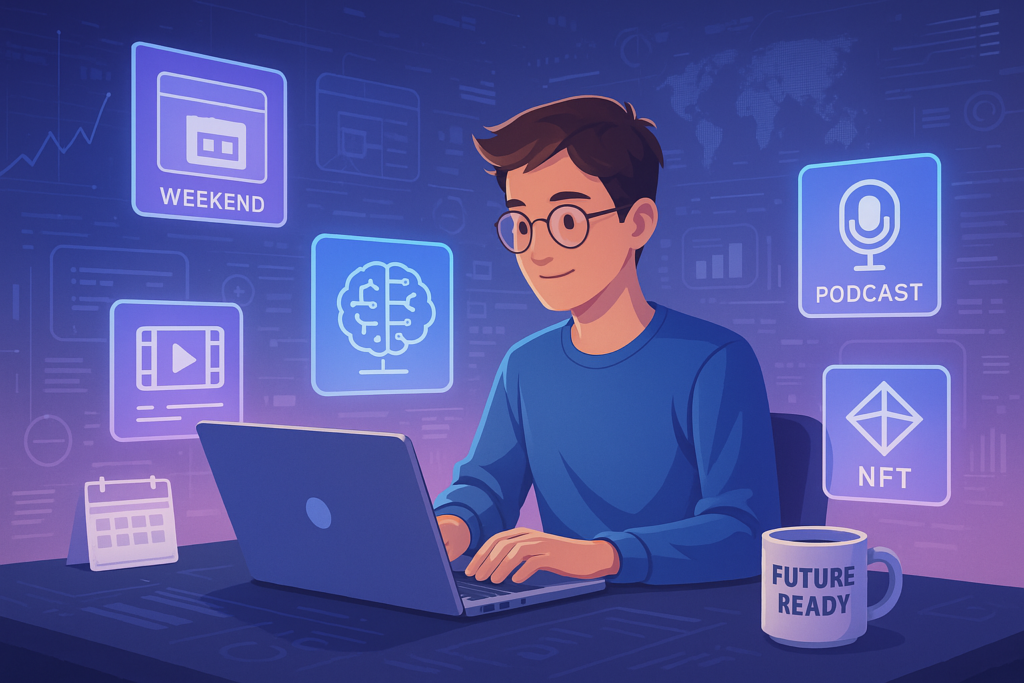Top 10 skills to learn for your future. I’ll be honest — a couple of years ago, I had no idea how fast the job market was about to change. Like most people, I assumed the traditional 9–5 route would always be the safest option. But then came remote work, AI tools like ChatGPT, the rise of freelance platforms, and suddenly everything shifted. The world of work became more about what you can do than where you work or what degree you hold.

That’s when I stumbled upon the idea of micro-gigs — short, skill-based tasks that anyone with the right know-how can do. It could be something like editing a podcast, designing a digital avatar, writing AI prompts, or even creating short video ads for niche platforms. What really surprised me? Many of these jobs don’t require years of experience — just a focused, practical skillset. Some can even be learned in a single weekend.
So I started researching the top 10 skills to learn for your future, not just for the sake of curiosity, but to future-proof my own income. I wasn’t looking for another course that would take months to finish. I wanted fast, useful skills that would open up real earning opportunities quickly — and ideally, let me work on my own terms.
That research turned into action. I picked a few skills, practiced them during weekends, and within a few weeks, I started picking up gigs on platforms like Fiverr and Contra. What I learned from that experience is exactly what I want to share with you today — because if you’re looking to adapt, grow, and earn in the new digital economy, the time to start is now.
In this blog post, I’ll walk you through the top 10 skills to learn for your future, especially if you want to tap into the growing micro-gig economy. These are skills that:
- You can start learning this weekend,
- Have strong potential in the coming years,
- And most importantly, are already being used to earn real money today.
Whether you’re a student, a stay-at-home parent, or just someone tired of the old-school job routine, these weekend-friendly skills could be your entry point into the future of work.
Ready to upgrade your weekends — and your future? Let’s dive into the list.
Why Micro-Gigs Are the Future of Work
A couple of years ago, when I first heard the term “micro-gigs,” I honestly thought it was just another buzzword. But the more I explored it, the more I realized how real — and relevant — it is becoming. Unlike traditional full-time jobs or even freelancing, micro-gigs are short, specific tasks that usually take a few hours or days to complete. Think of them as ultra-focused gigs — like writing a product description, editing a short video, or creating a quick landing page using no-code tools.

What really makes micro-gigs different is how skill-first and time-efficient they are. Companies aren’t always looking to hire someone full-time for a single task anymore. Instead, they want quick turnarounds, specific deliverables, and people who can plug in, do the job well, and move on. That’s the new reality — and it’s growing fast.
We’re seeing this shift because of a few powerful trends:
- Automation and AI are replacing repetitive jobs, pushing people to adapt by learning creative, human-focused skills.
- Remote work has unlocked talent from across the globe, making flexibility and agility more important than fixed hours or office presence.
- Web3 and decentralization are giving rise to new job formats, like community moderation, NFT management, and digital identity design.
- And of course, gig platforms like Fiverr, Upwork, TaskRabbit, and newer Web3 portals are fueling the demand for on-demand talent.
In this environment, the people who thrive aren’t necessarily the ones with the longest resumes or the fanciest degrees — they’re the ones who can learn fast, adapt quickly, and offer practical value through specific skills. And that’s where the concept of micro-gigs shines.
Here’s what I’ve personally learned: Short, sharp skills matter more now than ever before. You don’t need to spend four years in college or take a six-month course to make money online. You need to know how to do something valuable — and deliver it fast. That’s exactly why I put together the top 10 skills to learn for your future — because I wanted a list that cuts through the noise and focuses on what actually gets you hired in this new work landscape.
Micro-gigs aren’t just a trend; they’re a sign of where the world of work is heading. And the sooner you start building your skill stack, the better prepared you’ll be to not only survive, but thrive in the future job market.
In the next section, I’ll break down those top 10 future-ready skills you can start learning this weekend — each one chosen for its simplicity, market demand, and income potential in the micro-gig world.
Let’s get into it.
How to Choose the Right Future-Ready Skill
When I first realized how fast the job world was changing, I did what most people do — I opened YouTube, Googled “best skills to learn,” and immediately got overwhelmed. There were hundreds of options: data science, machine learning, copywriting, blockchain, UX design… and while they all sounded impressive, most of them came with a catch — they required months (if not years) to master.
But I wasn’t trying to become an expert overnight. I just wanted to find a skill I could pick up quickly and start using to earn real money, especially through micro-gigs or short-term projects. That’s when I started refining my criteria — what makes a skill not just interesting, but truly future-ready?
Through trial and error (and a few failed weekends, if I’m being honest), I discovered three essential things to look for:
🔹 1. Learnability in a Weekend
If a skill takes more than 2–3 days just to understand the basics, it’s probably not ideal for someone who’s just starting out or balancing other responsibilities. The best micro-gig skills have a low barrier to entry — meaning you can learn the fundamentals in a weekend, practice a bit, and start applying them in real-world tasks. Tools like ChatGPT, Canva, and Notion AI are great examples — you can get functional in a day or two and start offering services quickly.
🔹 2. High Demand in the Future
This part took a bit of digging. I didn’t just want a skill that was trending now — I wanted one that would still matter 2–5 years down the line. So I looked at what was growing: AI content creation, automation tools, virtual branding, audio content, and remote-first services. The good news? Many of the skills I ended up putting into my top 10 skills to learn for your future list are already in demand — and that demand is only going to increase.
🔹 3. Compatibility with Remote and Micro-Gig Work
Some skills are super valuable — but not very micro-gig friendly. I needed to focus on skills that could be done remotely, delivered digitally, and broken down into small, paid tasks. Whether it’s designing quick thumbnails, writing chatbot scripts, editing short AI-generated videos, or doing voiceovers for reels — these are jobs that don’t require you to be in an office or commit long term.
💡 Pro Tip: Start with Just One or Two
One mistake I made early on was trying to learn everything at once. Don’t do that. It’s better to pick one or two skills that genuinely interest you, focus on them over a weekend, and test the waters. Watch a few tutorials, practice with free tools, and maybe even post a sample on LinkedIn or Fiverr. The goal isn’t perfection — it’s momentum.
If you’re unsure where to begin, the next section will make things a whole lot easier. I’ve compiled the top 10 skills to learn for your future — all beginner-friendly, micro-gig compatible, and ready for you to explore this weekend.
Let’s break them down one by one.
Top 10 Skills to Learn for Your Future (Weekend-Friendly)
As someone who’s experimented with different side hustles and online work formats, I can tell you firsthand — choosing the right skill makes all the difference. Below are the top 10 skills to learn for your future, each handpicked because they’re beginner-friendly, adaptable to micro-gigs, and can be learned in just a weekend (yes, really). I’ve included what each skill is, why it matters in the future of work, how to start learning, and what kinds of gigs you can expect to land.
1. AI Prompt Writing
What It Is:
The ability to craft detailed, clear, and structured prompts that guide AI tools like ChatGPT, Midjourney, or Claude to generate specific outputs — whether it’s text, code, images, or ideas.
Why It Matters:
As AI tools become embedded in every workflow, prompt writing is becoming a foundational skill. It’s no longer about “using” AI — it’s about “communicating” with it effectively. This is already a job category on sites like Upwork and PeoplePerHour.
How to Start This Weekend:
- Play with ChatGPT, Gemini, or Midjourney.
- Take a free course on YouTube or PromptHero.
- Start a “Prompt Portfolio” — test prompts and share results on LinkedIn.
Related Micro-Gigs:
- Prompt engineering for businesses
- Prompt optimization for AI-generated images
- Writing prompt sets for AI art platforms
- Creating educational prompt packs for creators
2. Basic No-Code Development
(e.g., Bubble, Glide, Webflow)
What It Is:
Building apps, tools, or websites using visual platforms — no traditional coding needed.
Why It Matters:
Startups, solopreneurs, and even large companies now use no-code tools to launch MVPs and internal dashboards. The demand for “builders who don’t code” is growing rapidly.
How to Start This Weekend:
- Create a simple project on Bubble.io or Glide
- Use Webflow’s free university
- Follow a “clone and modify” YouTube tutorial
Related Micro-Gigs:
- Build MVP landing pages
- Internal tools for small businesses
- Client portals or lead gen tools
- Custom Webflow website design
3. Voiceover/Narration for AI-Generated Content
What It Is:
Recording human voiceovers to enhance AI-generated videos, reels, explainers, or educational content.
Why It Matters:
As content creation becomes more automated, real voices are in demand for authenticity. TikTok, YouTube Shorts, and AI video platforms all need narration.
How to Start This Weekend:
- Use your smartphone and a free DAW like Audacity
- Practice reading scripts from YouTube videos
- Record and upload a sample on Fiverr or Voices.com
Related Micro-Gigs:
- Narrating AI-generated scripts
- TikTok/Instagram reel voiceovers
- Explainer video VO for startups
- Audiobook voice samples for short stories
4. Image/Video Editing with AI Tools
(Runway ML, Pika Labs, Canva, Descript)
What It Is:
Using AI-assisted tools to clean up, enhance, or auto-generate visual content with minimal effort.
Why It Matters:
These tools let beginners create studio-level visuals. They reduce the skill barrier — but you still need a good eye and basic editing sense.
How to Start This Weekend:
- Use Canva’s video editor or Runway ML
- Try Descript’s “Remove Filler Words” and “Overdub” tools
- Watch tutorials from creators using Pika Labs
Related Micro-Gigs:
- Short-form content edits for brands
- YouTube thumbnail creation
- Instagram video editing
- TikTok transitions and cleanups
5. UX Writing for Micro-Interfaces
(Chatbots, Smartwatches, IoT)
What It Is:
Writing concise, user-focused micro-text for digital interfaces — e.g., what a chatbot says or how a smartwatch displays an alert.
Why It Matters:
As interfaces shrink, clarity becomes king. UX writing is growing fast, especially in apps, wearables, and smart devices.
How to Start This Weekend:
- Study real microcopy examples (e.g., Google, Apple, Duolingo)
- Write sample chatbot dialogues
- Take a free UX writing course on Medium or YouTube
Related Micro-Gigs:
- Chatbot script writing
- UX text for mobile or smartwatch apps
- Copy cleanup for app developers
- UX audits of existing interfaces
6. Microcopy & SEO Snippet Writing
What It Is:
Writing ultra-short text — like meta descriptions, product taglines, CTAs, and blog snippets — optimized for SEO and conversion.
Why It Matters:
With the rise of AI search and voice search, short-form, context-rich writing is in demand. Also, Google still loves well-crafted snippets.
How to Start This Weekend:
- Write sample snippets for 5 fake products
- Learn keyword basics on Ubersuggest
- Optimize your own social bios or blog headlines
Related Micro-Gigs:
- Meta descriptions for blog posts
- CTA buttons for ecommerce sites
- Amazon product short copy
- SEO audits for snippets and meta tags
7. Avatar Styling & Digital Fashion Design
(For Metaverse or AI-generated content)
What It Is:
Designing virtual outfits, accessories, and avatars for digital worlds, social media AI influencers, or games.
Why It Matters:
Digital fashion is becoming huge — from Roblox and Fortnite skins to AI-generated avatars used in content and branding.
How to Start This Weekend:
- Use tools like ReadyPlayerMe, Daz 3D, or Zepeto
- Play with Midjourney prompts to create fashion looks
- Sketch designs in Canva or Procreate
Related Micro-Gigs:
- Outfit packs for avatars
- Digital fashion mood boards
- Style concepts for AI influencers
- Branded avatar design for companies
8. Podcast Editing (Short-form or AI-assisted)
What It Is:
Editing raw audio, adding music, removing fillers, and polishing content using tools like Descript or Alitu.
Why It Matters:
With podcasting still booming, short, polished clips for reels, previews, and trailers are in high demand — especially among solo creators and micro-influencers.
How to Start This Weekend:
- Download a podcast sample (or record your own)
- Use Descript to edit filler words and add captions
- Create 3–5 short clips under 1 min each
Related Micro-Gigs:
- Trailer editing for new podcasters
- Short-form podcast snippets for reels
- Audio cleanup for interviews
- Captioning + format conversion
9. NFT Metadata Creation & Management
What It Is:
Structuring, tagging, and writing metadata for NFT collections, including traits, rarity levels, and smart contract descriptions.
Why It Matters:
Even with the crypto slowdown, NFT infrastructure continues to evolve. Creators and agencies need help with the “boring but essential” backend work.
How to Start This Weekend:
- Learn the structure of an NFT project
- Explore metadata templates on GitHub
- Try OpenSea test minting to see how metadata appears
Related Micro-Gigs:
- Metadata cleanup for collections
- Trait writing for generative NFTs
- Collection formatting for marketplaces
- Data entry for NFT launchpads
10. Micro-Influencer Growth on Niche Platforms
(e.g., Lemon8, Threads, Substack, Flipboard)
What It Is:
Building and managing presence on rising platforms — focusing on small, engaged audiences rather than viral metrics.
Why It Matters:
As social fatigue grows, brands are turning to micro-influencers with loyal, niche followings. Early movers on platforms like Lemon8 or Threads are seeing rapid traction.
How to Start This Weekend:
- Pick a niche (travel, books, AI tools, minimalism)
- Create and post 3–5 high-quality pieces
- Engage in comments and track basic analytics
Related Micro-Gigs:
- Niche content creation
- Platform growth consulting
- Collaboration brokering for small creators
- Affiliate marketing via micro-review posts
Final Thoughts
If you’ve made it this far, I hope this list of the top 10 skills to learn for your future feels less overwhelming and more exciting. The beauty of this moment in time is that you don’t need to wait years to build your career. You can start small — a weekend at a time — and grow from there.
Whether you choose AI prompt writing, UX microcopy, or digital fashion for avatars, the key is just to begin. Pick a skill, give it a real try, and put your work out there.
Your next opportunity might not come from a degree — it might come from a tweet, a gig post, or a DM from someone who saw your prompt, your edit, or your voice clip.
And that? That’s the future of work.
Tools to Learn Fast (Over the Weekend)
If you’ve ever said to yourself, “I wish I had more time to learn new skills,” I totally get it. I used to think the same. But here’s the truth I discovered: with the right tools, you don’t need months — sometimes just one focused weekend is enough to get started. That’s exactly how I got into AI prompt writing and no-code tools. I carved out a Saturday, turned off notifications, and dove into the best resources I could find.
Whether you’re starting from scratch or switching careers, the platforms below will help you learn the top 10 skills to learn for your future faster than you think.
🎥 YouTube Channels: Free, Visual & Fast
YouTube is a goldmine for learning new skills — especially micro-gig-friendly ones. The trick is to follow creators who simplify complex topics and provide hands-on tutorials instead of fluff.
🔹 Futurepedia
Great for discovering new AI tools and walkthroughs on how to use them. It’s especially helpful for learning skills like AI video editing, prompt engineering, and voiceover automation.
🔹 Ali Abdaal
A productivity guru who covers not only how to learn fast, but also how to monetize skills like UX writing, content creation, and automation. His “learning in public” style really resonates with me.
🔹 Flux Academy (Web Design)
If Webflow or no-code design is on your list (which it should be — it’s one of the top 10 skills to learn for your future), this is the channel you want. Practical, beginner-friendly, and deeply valuable.
🔹 Matt Wolfe / TheAIFuture
Matt is like your personal AI scout — always sharing the latest tools, trends, and use cases. If you’re curious about micro-gigs related to ChatGPT, Descript, or image generation, subscribe here.
📚 Online Courses: Deep Dives in a Structured Format
When I needed a more guided path — especially for skills like podcast editing or UX writing — I turned to structured courses. These are a little more intensive than YouTube, but also more focused.
🔸 Udemy
The king of affordable, skill-specific learning. You can find weekend-sized courses on anything from “Prompt Engineering for Beginners” to “Start Your First No-Code App.”
Pro Tip: Always wait for Udemy’s $9.99–$13.99 sales. They happen almost every week.
🔸 Coursera
If you want to go deeper into foundational knowledge (like the psychology behind UX writing or fundamentals of digital marketing), this is great. It’s more academic, but still micro-skill friendly.
🔸 Domestika
Perfect for creative gigs — think avatar styling, digital fashion, podcast editing, or aesthetic content creation. The instructors are usually real-world professionals, which I love.
🤖 AI Tools: Practice While You Learn
The beautiful thing about learning the top 10 skills to learn for your future is that many of them involve using AI tools — and those tools teach you as you go. It’s like learning Photoshop by designing real graphics, not just reading a textbook.
🔹 ChatGPT
Ideal for:
- Practicing prompt writing
- Writing microcopy or chatbot conversations
- Creating SEO snippets in minutes
I use it daily to experiment with different writing styles and generate examples I can tweak or refine.
🔹 Canva (Pro Recommended)
Great for:
- AI-based design
- Image/video editing
- Thumbnail creation
It’s a no-brainer tool if you’re into visual micro-gigs. Their Magic Studio features (AI-generated visuals, auto-background remover, etc.) are game-changers.
🔹 Synthesia
If you want to explore voiceover, narration, or AI video creation, Synthesia lets you generate professional-quality content in minutes. You write the script, choose an avatar, and boom — instant video.
🔹 Notion AI
This one’s a hidden gem. I use it to:
- Organize skill-learning plans
- Generate blog outlines
- Create simple automations and content databases
It’s especially useful if you’re into no-code workflows or want to build digital products down the line.
🎯 Final Thoughts
What I’ve learned through my own journey is that learning the top 10 skills to learn for your future doesn’t require waiting for the “right time.” You already have everything you need — the tools, the platforms, and most importantly, the mindset.
Start by choosing just one of the skills that interests you. Then pick a tool from this list. Whether it’s a YouTube channel or an AI app, commit just one weekend to explore it — not to master it, but to get your hands dirty and start.
That’s how momentum begins. And in the world of micro-gigs and future work, momentum matters more than credentials.
Ready for the next step? Let’s talk about how to monetize your new skill once you’ve practiced it — want me to help you build out Section 5 next?
How to Turn Skills into Paid Micro-Gigs
So, you’ve spent a weekend or two diving into some of the top 10 skills to learn for your future — great job! But now comes the big question: How do I actually start earning from these skills?
Trust me, this is where many people get stuck. Learning is only half the journey. The other half is packaging yourself right and connecting with clients who need what you can offer. The good news? The micro-gig economy has exploded, and there are tons of platforms designed specifically for small, skill-based jobs. Let me share what’s worked for me.
🚀 Where to Find Micro-Gigs
Here are some of the best places to start your journey as a paid micro-gigger:
- Fiverr — The classic marketplace for small gigs. Whether it’s AI prompt writing, microcopy, or podcast editing, Fiverr is where clients look for fast, affordable talent.
- Upwork — Better for slightly longer projects or repeat clients. Great if you want to build ongoing relationships around your weekend-learned skills.
- Contra — A newer platform focused on independent creators and freelancers, perfect for digital nomads who want flexible gigs.
- Polywork — Focused on showcasing your multi-skilled portfolio, ideal if you’re blending several micro-skills.
- Web3 Platforms — If you’re diving into NFT metadata or digital fashion design for the metaverse, platforms like Opensea, Rarible, or decentralized freelance hubs are emerging spots to explore.
💡 Tips for Crafting a Killer Profile
Your profile is your storefront, so make it count. Here’s what I learned from trial and error:
- Clear & Friendly Introduction: Lead with your specialty from the top 10 skills to learn for your future. For example, “I help businesses create powerful AI prompts that generate creative content in minutes.” Be confident but approachable.
- Highlight Weekend Learnability: Mention how you quickly picked up the skill — it shows adaptability and eagerness, which clients love.
- Show Results, Not Just Features: Instead of “I do voiceovers,” say, “I create clear, engaging voiceovers that bring AI-generated scripts to life.” Focus on what clients gain.
- Add a Professional Photo: A warm, genuine picture goes a long way in building trust.
- Include Keywords: Sprinkle your profile with keywords like “micro-gigs,” “AI tools,” “no-code development,” or any skill from the top 10 skills to learn for your future to get found easily.
🛠️ Creating Samples with Free Tools
Clients want proof. You don’t need paid gigs to build a portfolio — just get creative:
- Use Canva or Runway to make sample videos or graphics.
- Record your own AI prompt results and share before-and-after examples.
- Create mockups of UX writing or chatbot scripts.
- Build a tiny no-code app on Bubble or Glide and share the link.
- Edit a public domain podcast episode with free tools and show your work.
These samples show that you can deliver, even before your first paid job. It’s a huge confidence booster.
💸 Setting Up Pricing and Scaling Your Micro-Gig Business
Pricing can feel tricky, but here’s a simple way I approached it:
- Start Low to Build Reviews: For your first 3–5 gigs, set competitive prices. This helps you build a reputation fast.
- Use Tiered Pricing: Offer basic, standard, and premium packages. For example, a quick AI prompt creation for $10, a set of 5 prompts for $40, and a customized prompt research package for $80.
- Upsell Smartly: Once you’ve proven your skills, add extras like faster delivery, revisions, or bundled services.
- Scale by Automating Repetitive Tasks: Use AI tools (ChatGPT, Canva’s Magic Write, etc.) to speed up work and take on more gigs without burning out.
- Ask for Testimonials and Referrals: A strong review is your best marketing tool in the micro-gig world.
Final Thought
Turning your newly learned skills into paying gigs is 100% doable — you just need a plan, persistence, and the right platforms. Focus on mastering a couple of the top 10 skills to learn for your future, build a killer profile, and start experimenting with pricing and samples. Over time, those small weekend learnings will snowball into real income streams and opportunities you never thought possible.
Conclusion
Looking back on everything we’ve covered, one thing is clear: the future of work isn’t about degrees or years spent in classrooms. It’s about skills — practical, adaptable skills you can learn quickly and apply immediately. The world is shifting to a skill-based economy, especially with the rise of micro-gigs and AI-driven tools. If you want to stay ahead, focusing on the top 10 skills to learn for your future isn’t just smart — it’s essential.
From AI prompt writing to no-code development, voiceover, microcopy, and beyond, these skills are opening doors to new, flexible income streams that anyone can tap into. And here’s the best part: you don’t need to wait months or years to get started. Pick just one skill from the list, commit to learning it this weekend, and you’ll already be ahead of most people who keep waiting for the “perfect time.”
I’ve been there — juggling work, life, and trying to find time to upskill. But what helped me was breaking down learning into small, actionable chunks and using the right tools and platforms to make every minute count. You can do the same.
If you found this guide helpful, make sure to subscribe so you don’t miss out on weekly updates about future job trends, actionable skill guides, and micro-gig opportunities. And if you want a handy cheat sheet summarizing the top 10 skills to learn for your future along with quick-start resources, just download my free resource below.
Remember: the future favors those who act — not those who wait. So dive in, learn fast, and start building your future, one weekend at a time.







